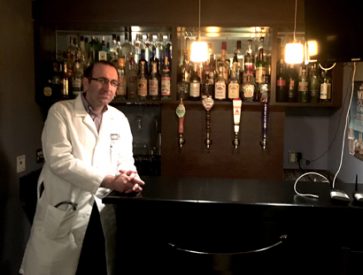News
Peptides, Bugs and Lancets: The Gut-Brain Axis & Alcohol Use Disorder, by Lorenzo Leggio, MD, PhD, MSc

Editor’s note: PGDF’s Advisory Council (AC) is comprised of experts from across the field of addiction. In this new series, we invite AC members to share their expertise and experience with PGDF constituents.
Advisory Council member Dr. Lorenzo Leggio is the Chief of the Section on Clinical Psychoneuroendocrinology and Neuropsychopharmacology (CPN), a joint National Institute on Alcohol Abuse and Alcoholism (NIAAA) and National Institute on Drug Abuse (NIDA) laboratory, where his research focuses on the treatment of alcohol use disorder, with a special emphasis on the role of feeding-related as well as GABAergic pathways; and on the medical consequences of alcohol use disorder, with a special emphasis on alcoholic liver disease.
Photo: Dr. Leggio in his “fake bar” laboratory at NIH
*****
We all use expressions like “go with your gut”, “gut feeling”, “my gut instinct”, etc., but perhaps we do not realize that these colloquial expressions reflect the complex anatomy and physiology of the bidirectional communication that exists between the gut and the brain. This communication is a unique opportunity to shed light on how our brain works; therefore, studying the gut-brain axis represents a tremendous novel opportunity to better understand our brain’s complexities and develop effective treatments for neuropsychiatric disorders. Among them, alcohol use disorder (AUD) is a leading cause of mortality and morbidity, yet treatments remain limited in number and efficacy. Therefore, there is a need to identify and develop novel treatments that may help individuals afflicted with AUD. Can the study of the gut-brain axis help us identify new therapeutics for our patients? We don’t know yet, but research is ongoing in both animal models and humans to provide answers. A few examples are provided next.
Peptides. Our gut produces several peptides, which function as hormones, not only in the periphery, but also in the brain. Whether these peripheral peptides travel directly into the brain or signal the brain is often a topic of controversy since hormones act via specific receptors, and for many hormones their receptors are present not only in the periphery, but also in the brain. For example, ghrelin, often called the “hunger” hormone, is primarily produced in the stomach, but it crosses the blood-brain barrier to send signals to the brain, where the ghrelin receptor is widely expressed. Ghrelin leads to increased appetite, meal initiation and food intake. The glucagon-like peptide-1 (GLP-1) is mainly produced by the intestine and its receptor is also expressed in the brain. In addition to lowering blood glucose, GLP-1 reduces appetite and food intake. Notably, ghrelin and GLP-1 have opposite effects in reward processing and hedonic motivation of eating food beyond the need for calorie intake. A variety of animal studies conducted in independent laboratories show that ghrelin administration increases alcohol reward and drinking, which by contrast are reduced by drugs that block the ghrelin receptor. On the other hand, drugs that block the GLP-1 receptor increase alcohol reward and drinking, but these responses are reduced by GLP-1 or its analogs. Clinical studies are now ongoing to understand whether these observations in animals may be translated to humans. In summary, ghrelin, GLP-1 and other peptides play important roles in the bidirectional communication between the gut and the brain, and studying these hormonal pathways has the potential to facilitate the development of innovative treatments for AUD.
Bugs. It is a fair statement to say that we are never alone. In fact, our body is host to around 100 trillion microbes in several locations throughout the body, but particularly in the gut. The gut microbiota serves a wide range of functions that extend beyond the physiology of the gut itself. Recently, the important role of the microbiota-gut-brain axis has emerged and several animal studies provide evidence that indeed the gut microbiota plays a role in a variety of neuropsychiatric disorders. For example, it has been described that a fecal transplantation from anxious rats to non-anxious rats leads to the development of anxious behaviors in the non-anxious rats. Clinical research on this topic is in its infancy, especially in the AUD field, so additional work is needed to understand whether research on the gut microbiota may help develop new treatments for AUD and/or other neuropsychiatric disorders.
Lancets. Bariatric surgery is an effective treatment for obesity and its complications (e.g., diabetes). Studies conducted both in Europe and in the U.S.A. report that some patients who had bariatric surgery, especially gastric by-pass, consequently report increased alcohol drinking and even development of AUD after the surgery. Similarly, obese rats given bariatric surgery consume more alcohol compared to the control groups with sham surgery. These observations are significant from a safety standpoint, as they suggest the importance of close monitoring of alcohol use in these patients post-operatively. From a mechanistic standpoint, these observations provide further evidence on the importance of the gut-brain axis (manipulated surgically in this case) in the development and management of AUD. Many years ago, a popular book, “The Second Brain” by Dr. Michael Gershon, described the importance of the peripheral nervous system for the gut, since it acts as a ‘brain’, and indeed may control our gut all by itself. Perhaps it may be a stretch to name the brain as “The Second Gut”, but clearly studying the effects of the gut on the brain is a unique approach that may help us better understand AUD and other neuropsychiatric disorders, and hopefully lead to the development of additional safe and effective treatments for AUD.
Lorenzo Leggio, MD, PhD, MSc
Chief, Section on Clinical Psychoneuroendocrinology and Neuropsychopharmacology (CPN), National Institute on Alcohol Abuse and Alcoholism Division of Intramural Clinical and Biological Research & National Institute on Drug Abuse Intramural Research Program, National Institutes of Health, Bethesda, MD
Associate Director for Clinical Research, Medications Development Program, National Institute on Drug Abuse Intramural Research Program, Baltimore, MD
Professor (Adjunct), Brown University, Providence, RI